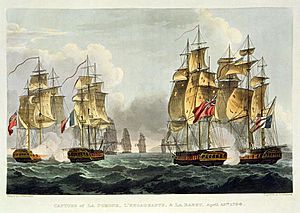Action of 23 April 1794 facts for kids
Quick facts for kids Action of 23 April 1794 |
|||||||
|---|---|---|---|---|---|---|---|
| Part of the naval operations during the War of the First Coalition | |||||||
 Capture of Pomone, Engageante and Babet by Thomas Whitcombe |
|||||||
|
|||||||
| Belligerents | |||||||
| Commanders and leaders | |||||||
| Strength | |||||||
| 3 frigates 1 corvette |
5 frigates | ||||||
| Casualties and losses | |||||||
| 2 frigates and the corvette captured. Pomone: 80 and 100 killed and wounded Babet: 30 and 40 killed and wounded Engageante: 30 to 40 men killed and wounded |
Flora: 1 killed, 3 wounded Arethusa: 3 killed, 5 wounded Melampus : 5 killed, 5 wounded Concorde: 1 killed, 12 wounded |
||||||
The Action of 23 April 1794 was a naval battle that happened during the French Revolutionary Wars. It was fought between a group of five British warships, led by Sir John Borlase Warren, and a group of four French warships. The battle took place near the island of Guernsey. In the end, the British won, capturing three of the French ships.
Contents
What Happened in the Battle?
The Chase Begins
On April 21, 1794, a British warship called Minerva was sailing in the English Channel. Its crew spotted four ships far away. The next morning, Minerva met up with Sir John Borlase Warren's group of ships. They told him what they had seen.
Warren quickly decided to chase the unknown ships. Early the next day, around 4 a.m., his ships spotted three French frigates and one corvette. They were about 25 to 28 nautical miles southwest of Guernsey.
The Main Fight
The French ships got into a battle line, ready to fight. Warren told his ships to attack. His own ship, Flora, led the way, with Arethusa right behind it.
The British ships had an advantage because of the wind direction, which is called the weather gage. This allowed them to get very close to the French ships. The battle was intense and lasted for almost three hours. Around 11 a.m., two French ships, the Pomone and Babet, surrendered.
The Chase Continues
After the first part of the battle, two other French ships, the Engageante and Résolue, tried to get away. Warren ordered three of his ships—Concorde, Melampus, and Nymphe—to chase them. His own ship, Flora, was too damaged to join the pursuit.
After about an hour, Concorde caught up with Engageante. Concorde tried to damage Engageante so it couldn't move. The plan was for Melampus and Nymphe to then capture Engageante, while Concorde went after Résolue.
However, while Concorde was fighting Engageante, Résolue turned back. It sailed across the front of Concorde, badly damaging its sails and ropes. This made Concorde unable to move well.
After quick repairs, Concorde went back to fight Engageante. Finally, Engageante surrendered around 1:45 p.m. Résolue fired a few more shots and then escaped. Melampus and Nymphe chased Résolue all the way to Morlaix before returning. They then helped Concorde tow the damaged Engageante back to port.
Ships Involved
British Ships
- Flora (36 guns), led by Sir John Borlase Warren (flagship)
- Arethusa (38 guns), led by Sir Edward Pellew
- Melampus (36 guns), led by Thomas Wells
- Concorde (32 guns), led by Sir Richard Strachan
- Nymphe (36 guns), led by George Murray
French Ships
- Engageante (26 guns), led by F. Desgarceaux (flagship) - Captured by Concorde
- Pomone (44 guns), led by Étienne Pévrieu - Captured by Arethusa
- Résolue (36 guns), led by Antoine-Marie-François Montalan - Escaped
- Babet (22 guns), led by Pierre-Joseph-Paul Belhomme - Captured by Arethusa

